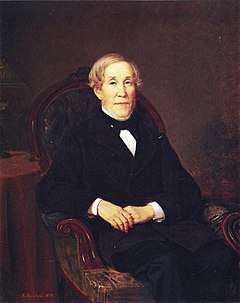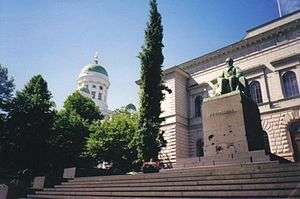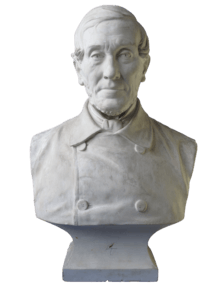Johan Vilhelm Snellman
Johan Vilhelm Snellman (Swedish pronunciation: [ˈjǔːhɑn ˈvǐlːhelm ˈsnělːmɑn] (![]()
Johan Vilhelm Snellman | |
|---|---|
 Portrait of Snellman by Bernhard Reinhold from 1874. | |
| Born | 12 May 1806 |
| Died | 4 July 1881 (aged 75) |

Life and career
Snellman was born in Stockholm, Sweden, the son of Kristian Henrik Snellman, a ship's captain. After the Russian conquest of Finland in 1808–09, and the promising establishment of the semi-autonomous Grand Duchy of Finland, his family moved there in 1813, to the Ostrobothnian coastal town of Kokkola, where his mother Maria Magdalena Snellman died only a year later.
In 1835, after academic work amongst followers of Hegel, Snellman was appointed lecturer at the University of Helsinki, where he belonged to the famous circle of Cygnaeus, Lönnrot, and Runeberg comprising the brightest of their generation. Snellman's lectures quickly became popular with the students, but in November 1838 his lectureship was temporarily recalled after a judicial proceeding that ultimately aimed to establish firm governmental control of new and oppositional thought among the academics.
As a consequence Snellman exiled himself to Sweden and Germany, more or less voluntarily, from 1839 to 1842. By the time he returned to Helsinki, his popularity had increased further, but the political juncture did not allow the university to employ him. Instead, he took up the position as headmaster for a school in distant Kuopio and published starkly polemical periodicals, including the paper Saima in Swedish, which advocated the duty of the educated classes to take up the language of the then circa 85% majority of Finns, and develop Finnish into a language of the civilized world, useful for academic works, fine arts, state craft, and nation building.
Saima was suppressed by the government in 1846. In 1848–49, Snellman was again rebuffed when applying for the position of professor at Finland's University in Helsinki. After having contemplated a renewed exile in Sweden, this time possibly definitive, Snellman in 1850 gave up the position in Kuopio and moved to Helsinki, where he and his family lived under economically awkward conditions until the death of Emperor Nicholas in 1855, when it again became possible for Snellman to publish periodical papers on political issues.
In 1856, Snellman was finally appointed professor, which was met with great satisfaction among politically interested Finns. However, Snellman's unparalleled popularity could not remain. He was a generation older than the most active political opposition, and now a man of the government who had the brightest expectations for Finland under the rule of Emperor Alexander II. The language strife in Finland, which he was the chief initiator of, contributed also to substantial opposition against him and his views, and finally not the least his stance against the Polish rebels of the January Uprising of 1863 was seen by many as the ultimate sign of unprincipled ingratiation.
In 1863 Snellman was called to a cabinet post in the Senate of Finland, in effect as Chancellor of the Exchequer, where he became an energetic and valued senator, accomplishing a language decree from the Emperor that would gradually give Finnish a position equal to that of Swedish within the Finnish government, and thereby practically in Finland at large, the re-establishment of the Parliament, which had remained inhibited since the Russian conquest.
Separate Finnish currency, the Markka, was introduced in 1860, and Snellman managed to tie it to silver instead of to the ruble.[1] The Markka came to be of the utmost value for Finland. Snellman's tenure as Finance Minister would be tainted by the Finnish famine of 1866–1868, aggravated by the government's strict fiscal policy, but Snellman worked to get aid while trying to protect the new currency.[1]
Snellman's inflexibility and high prolific position in the political debate would however, together with his old reputation as radical agitator of the 1830s–1840s, accumulate too much resistance and aversion to his person and his policies. In 1868 he was forced to resign from the senate.
For the remainder of his life, he continued to participate in the political debate, and now ennobled he belonged to the Nobles' Chamber of the parliament. Snellman never lost in popularity among his Fennoman followers, but he had become a highly divisive symbol in Finland's political landscape.

Honors
Johan Vilhelm Snellman first appeared on a 1960 coin, commemorating the introduction of the markka denomination in 1860. He was recently selected as the main motif for another commemorative coin, the €10 Johan Vilhelm Snellman commemorative coin, minted in 2006 celebrating the 200th anniversary of his birth. The obverse depicts J.V. Snellman. It also depicts the logo of the Europe Coins Programme. The reverse design features represent the dawn of Finnish culture.
Works
In 1842 Snellman published his foremost work Läran om staten (Study of the State).
References
- Klinge, Matti. "Snellman, Johan Vilhelm (1806 - 1881)". The National Biography of Finland. Retrieved 24 November 2017.
- http://finland.fi/Public/default.aspx?contentid=160109&nodeid=37598&culture=en-US
- http://www.kansallisbiografia.fi/english/person/3639
- http://global.britannica.com/EBchecked/topic/550446/Johan-Vilhelm-Snellman
- http://runeberg.org/authors/snellman.html
- http://www.taidemuseo.fi/english/veisto/veistossivu.html?id=95
External links
| Wikimedia Commons has media related to J. V. Snellman. |